reckoning with an animal that sees us as prey — living and working in crocodile country
- Written by Michael Bradley, Postdoctoral Research Fellow, James Cook University
The wet season in tropical Australia begins with tension. Physical tension, caused by the friction of earth and clouds. Mental tension, caused by the heat, and the expectation of rain and relief. It is also an ecological tension, where every plant and animal is poised — genetically, physiologically — to grow, reap, sow and copulate within a few short months.
We call it the build-up. The tension builds, and then it breaks. It was at the point of breaking when Val Plumwood, a young philosopher from the temperate south, was taken by a crocodile.
She was an environmental activist, exploring Kakadu to experience the wilderness she’d had a hand in protecting. She was paddling upstream in a small, red, low-sided canoe when it began to rain. There are many attacks on visitors to the tropics, especially those in small watercraft, but we know more about this one than any other.
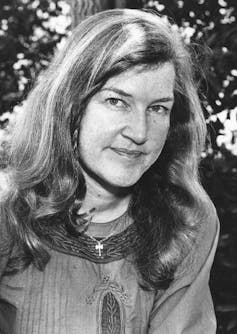 Val Plumwood.
CC BY-NC-ND
Val Plumwood.
CC BY-NC-ND
When Val began fighting for the protection of wild places in the 1970s, the saltwater crocodile was rare almost to the point of extinction. By the mid ‘80s they were protected, plentiful, and in remote places, lacked memory of the hunters’ gun. When Val climbed into her vessel that morning in 1985, she did so in good faith. They were not a known threat to someone travelling by canoe in a back channel lagoon.
But crocodiles are a threat. Young salties eat fish and crabs. As they grow, they move on to larger prey — dogs, pigs, people, horses and buffalo. Our species fits comfortably in their diet, slipping into the line-up between pigs and horses.
Crocodiles may be opportunistic hunters, but their encounters with prey aren’t chance. They think about it. They watch, and they learn. Wash your pots and pans on the riverbank every evening, and you are inviting an attack. For people along the coastline of the tropical arc between Eastern India and Australia, they colour the water’s edge with a lurking malice and the threat of a violent death.
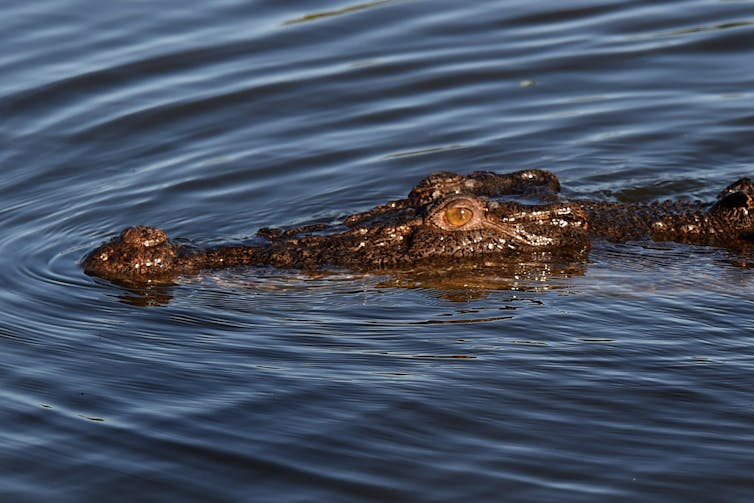 A crocodile in Kakadu.
Dean Lewins/AAP
A crocodile in Kakadu.
Dean Lewins/AAP
We share our world with other dangerous animals. Sharks, for instance, kill every year. Poisonous snakes too. However, there is a difference. Snakes strike when threatened, usually by an unintentional kick in the ribs. Sharks do bite when unprovoked, but rarely, and they almost never consume us. We share our beaches with them, but you can spend your life in the water and never get bitten. The saltwater crocodile is a different beast, and it boils down to intent. As crocodile researcher Professor Grahame Webb has put it:
There is no way of avoiding nor sugarcoating the predatory nature of saltwater crocodiles. If you dive off the Adelaide River bridge, 60 km east of Darwin’s city centre, and start swimming, there is a 100% chance of being taken by a saltwater crocodile. It is not the same as swimming with sharks.
Read more: Crocodile culls won't solve crocodile attacks
Fear and fascination
Like Val Plumwood, I too had come up north from the temperate south, and was not used to sharing my world with something that wanted to eat me.
There is a mountain range in north Queensland, cut off from the mainland by the sea. The space between is filled with a tangle of mangrove trees and snaking waterways. Heading down one of these channels in the early morning, my small boat cut around a bend, and on the far bank I saw a crocodile basking in the sun.
 Hinchinbrook Channel, North Queensland.
Kevin Crook
Hinchinbrook Channel, North Queensland.
Kevin Crook
I eased back on the throttle and let my boat drag through the water. This was my chance to see one up close, as long as I didn’t scare it off. I was a young scientist, new to the tropics, and hadn’t yet seen a croc up close. I’d glimpsed them sliding off the banks as I motored past, or as eyes above the waterline, following my boat with interest.
I drifted closer, engine idling.
It was big. I turned the engine off to let momentum and the current take me closer. I didn’t want to disturb the creature. Apart from the occasional snapping of pistol shrimp in their burrows, the air was still and quiet. The forest around us was a deep green, reflected in the greasy green of the water. The mud bank was almost black with silt; waist-deep, from recent experience. I could see the heft of the animal as I approached.
Its muscular tail rested in an arc, and the great mass of its body bulged, unsupported on dry land. It didn’t flinch as I drew closer, it held its jaws open in a permanent, basking yawn.
Now I was close enough to see very clearly its long pointed teeth ringing the muscular bed of the lower jaw. I could see sinew and texture in the enormous muscle that connects upper and lower jaw, allowing it to slam the two shut with the bite force of Tyrannosaurus rex. I could see it too well. Current and momentum had conspired to bring me right to the bank where the animal lay. I was no longer worried about disturbing the creature. I was within striking distance. I was an outsider, intruding, and I was afraid.
The fear and fascination never quite reconciled. I had seen the crocodile as an indicator, both in the ecological sense, as my training had described, but also in a personal sense.
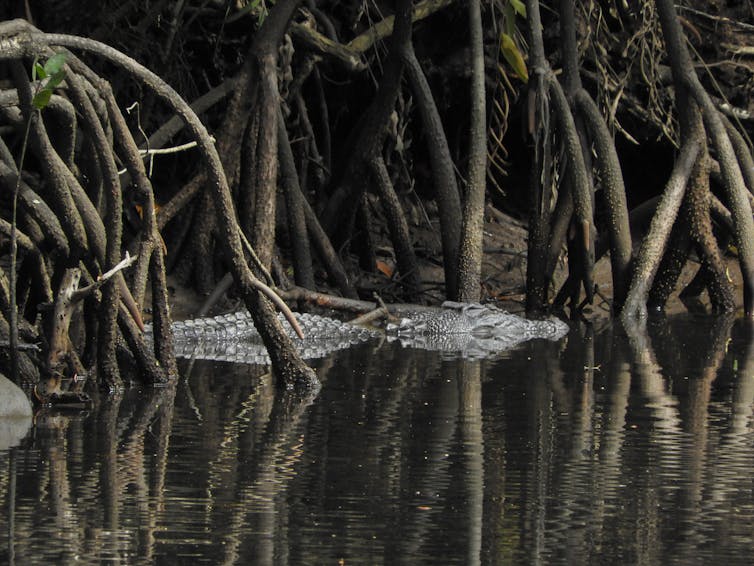 A crocodile in the mangroves of the lower Daintree River, Far North Queensland.
Kevin Crook
A crocodile in the mangroves of the lower Daintree River, Far North Queensland.
Kevin Crook
Ecologists like indicator species, because they tell us about a complex world in a very simple way. They stand in for a whole range of factors.
A caddis-fly larva can tell you about the purity of the alpine pond you found it in, how recently it was frozen and the stability of the seasons. A stingray can tell you about the flooding patterns of a sandbank and the abundance of invertebrates therein. They do this just by showing up. Crocodiles, to me, indicated nutrient rich tropical waters providing a glut of large bodied prey. Warm winters and big barramundi.
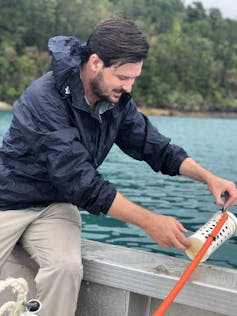 The author baiting a camera trap.
Sheree Marris
The author baiting a camera trap.
Sheree Marris
They indicated the sanctuary of the wild. Here was a place beyond the realm of humankind, remote, beautiful, and my place of work. They punctuated the landscape, and their presence transformed the place. In the temperate south, a bank in an inlet might be a good place to pull up for lunch, or cast a line. Here, it’s a place you don’t want to linger.
A floating log becomes an object of suspicion, and the value of a swimming hole, no matter how inviting, is measured in downstream barriers. We tend to hold crocs up as a symbols, and dangle the fact of their existence in front of southerners and tourists to prove our rugged credentials. But I had not reckoned with the animal itself.
As I fumbled for the ignition, the crocodile turned its full attention to me and slid down the bank. In one easy motion it slipped under the surface, and swam toward our boat.
I kicked the engine into gear. As the roar of my 15-horse motor sped us to safety, I wondered how on earth we live alongside these creatures. I also wondered how many of those 15 horses that croc could eat in its lifetime.
Living on the water’s edge
Crocodiles are not symbols — I was about to learn — they are living beasts capable of real material damage. I could venture into their world, but spent most of my time high above the waterline. For other people in that Indo-Pacific arc, contending with these animals is daily life. Work brought me to the islands of Papua New Guinea, where crocodiles are a threat to both people and property. While it might sound far flung, New Guinea is closer to my home in North Queensland than any Australian capital. It’s part of the same great landmass of Sahul, and shares a recognisable fauna and flora.
In the places I worked, people built their villages at the water’s edge, on volcanic black-sand beaches. That strip of coast contains all of everyday life; houses, fishing nets, canoes, livestock, children, dogs and cooking fires. So, when the largest reptile in the world crawls from the ocean of a nighttime, and carries away a squealing pig, it seems a reasonable price to pay. Especially considering the other potential prey sleeping in their beds.
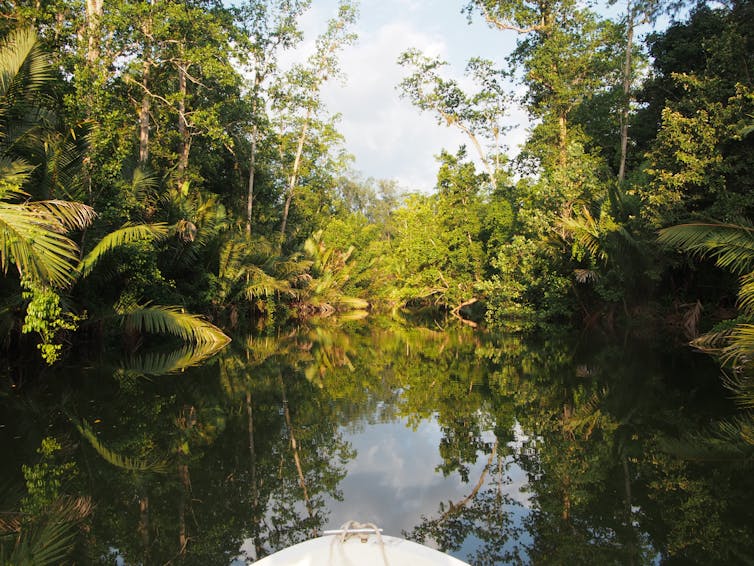 Moving through a back channel of the Langalanga estuary, West New Britain, Papua New Guinea.
Michael Bradley
Moving through a back channel of the Langalanga estuary, West New Britain, Papua New Guinea.
Michael Bradley
I came across one of these sacrificial pigs, postmortem. I was investigating the small estuaries along the coast with a local man named Alfonse. We turned into a small creek, hidden from view by the angle of its entrance and a tall forest of mangrove trees. Estuaries in the tropics have a certain smell caused by things that want to rot, but don’t have the air to do so. Sealed under the mud, they turn black and change their chemistry. Mixed in with this is the salt, and the fresh-sap of the mangrove leaves. Some people hate it, but I relish it.
This creek had an altogether different odour. It was the smell of rotting flesh, but not the dry waft of roadkill by the side of the road. This was wet-rot. The pig had been stashed in a dead tree on the bank, and its skin was beginning to trail in the current. Crocodiles don’t like a fresh kill; they like to let it soften. That pig would have fed a village and perhaps been the central meal of a wedding or a funeral. Now it was bloating in the muddy water.
On a different trip, Alfonse told me the story of a fatal attack in his village. Alfonse is a serious man with a young family, a gentle sense of humour and a legitimate hatred of Malaysian logging companies. We were working in a system called the Langalanga, a great palm swamp, almost cut off from the sea. In the slanted afternoon light, the marine palms reflect crazily on the black water, and their fruit-rot nectar clots the air.
Some of Alfonse’s family were camped on the edge of the swamp, and had set out in a canoe to collect mussels — a happy scene repeated on occasion throughout the seasons.
A few years back, another family was doing the same, when the father was taken by a crocodile. As he was being dragged under by the legs, his wife held on to his arms, and in that brief battle there was enough time for him to say “take care of the kids”. By the time I left, a man from our team was taken by a crocodile somewhere in that same labyrinth of palms.
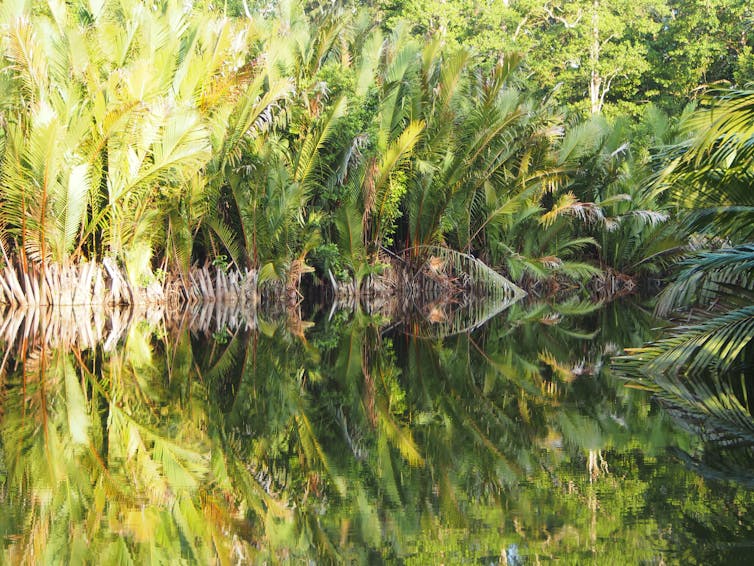 Late afternoon in the palm swamp, Langalanga estuary, West New Britain, Papua New Guinea.
Michael Bradley
Late afternoon in the palm swamp, Langalanga estuary, West New Britain, Papua New Guinea.
Michael Bradley
We are food
Crocodiles are murderous creatures. Not indifferent to our suffering, but actively in pursuit of it. They crave us, like we might crave a pizza, and they act on those impulses.
Val Plumwood learned this too, from the vantage point of her red canoe, as her path converged suspiciously with a floating log. The log was a crocodile, and from that point on, she was prey. The animal charged her craft several times. She tried to escape by climbing an overhanging tree. It burst from the water between her legs and clamped down on her torso. In that moment, in the force of realisation that accompanied the puncture wounds to her abdomen, she saw very clearly that she was food.
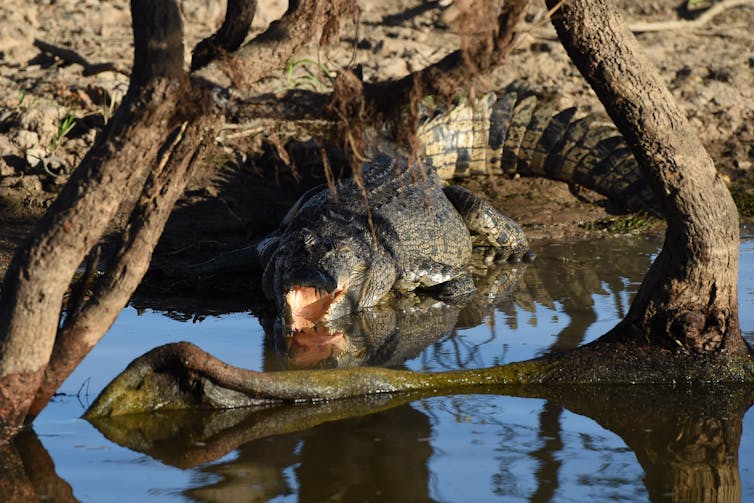 Murderous creatures: a crocodile in Kakadu.
Dean Lewins/AAP
Murderous creatures: a crocodile in Kakadu.
Dean Lewins/AAP
She was thrown into a death roll — crocodiles thrash with such force that all the air and struggle is sucked out of their prey, which they then hold underwater until drowned. Val, somehow, survived this experience. It was then repeated.
Incredibly, she surfaced and climbed to safety in the overhanging tree. She was plucked from the tree again, by her left leg, and the horror was repeated for the final time.
But, inexplicably, the crocodile’s jaws relaxed. Val wrestled free and scrambled up the mud bank. Her lower half was shredded, and she could see the raw meat of her leg muscle hanging from the bone. She staggered back through the bush until she began losing consciousness.
She gave out at the edge of the swamp, as the wet season floodwater rose around her. Here she accepted her end as food for the crocodiles waiting in the rising lagoon.
We know so much about this attack because Val survived it. But also because she was a philosopher. She didn’t just survive it, she thought about it, she examined its consequences, and she wrote about it.
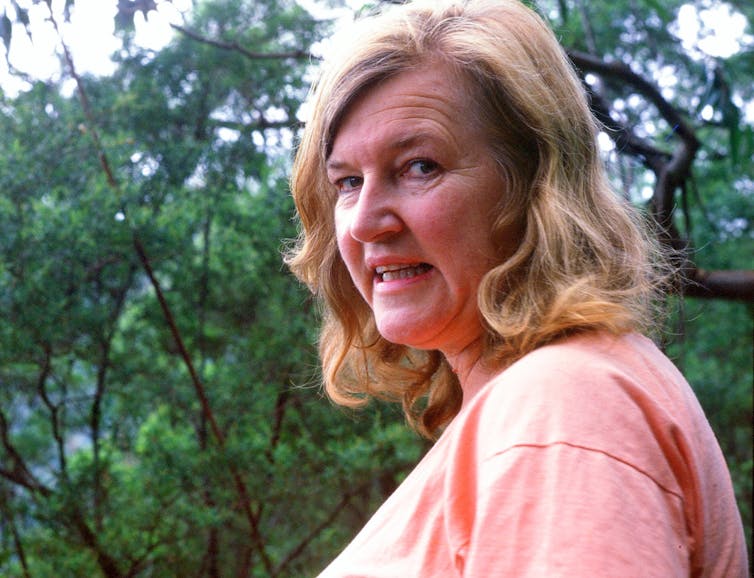 The Australian philosopher Val Plumwood pictured in 1990. In her work, Val interrogated the human-nature dualism that lies at the heart of modern culture.
Wikimedia Commons
The Australian philosopher Val Plumwood pictured in 1990. In her work, Val interrogated the human-nature dualism that lies at the heart of modern culture.
Wikimedia Commons
One of the key Australian thinkers of our time, she challenged the way we look at the natural world. It took her the rest of her life to fully reckon with the experience of being prey. The result is a revelation of a book, pulled together posthumously, (Plumwood died of a stroke in 2008), called The Eye of the Crocodile. Val’s experience has become a centre point for me, around which all my encounters with crocodiles now pivot. The anchoring wisdom in a confusing set of facts and impulses.
At the heart of her insight is the knowledge that we are food — “juicy, nourishing, bodies” for the rest of the animal kingdom. We forget that. Or perhaps, we never really come to know it. Val knew, but when she found herself as prey, she rejected the idea. I’ll let her speak for herself here:
My disbelief was not just existential but ethical — this wasn’t happening, couldn’t be happening. The world was not like that! The creature was breaking the rules, totally mistaken, utterly wrong to think I could be reduced to food. As a human being, I was so much more than food. Were all the other facets of my being to be sacrificed to this utterly undiscriminating use, was my complex organisation to be destroyed so I could be reassembled as part of this other being?
With indignation as well as disbelief, I rejected this event. It was an illusion! It was not only unjust but unreal! It couldn’t be happening. After much later reflection, I came to see that there was another way to look at it. There was illusion alright, but it was the other way around. It was the world of ‘normal experience’ that was the illusion, and the newly disclosed brute world in which I was prey was, in fact, the unsuspected reality, or at least a crucial part of it… both I and the culture that shaped my consciousness were wrong, profoundly wrong —about many things, but especially about human embodiment, animality and the meaning of human life.
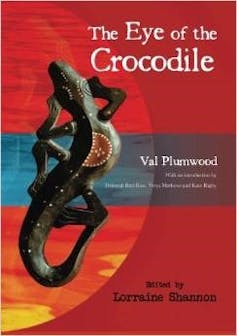 In the end, we are just another animal, scratching around on the surface of the earth. Like a few other terrestrial vertebrates, we sometimes forage in shallow seas and there, form part of the coastal food chain. In the Indo-Pacific arc, at this moment in ecological history, that food chain finishes with the saltwater crocodile.
They are simply the inheritors of their evolutionary mantle, held long before we ever dipped our toes in the water. In our brief history on this earth, we have rarely been at the top of our own food chains.
We are food, and not just for crocodiles. We live our lives trying to avoid eye contact with the fact, but it is always there in our peripheral vision. We are victim to a constant gnawing of insects, bacteria, fungus, and when we die — no matter how hard we try to bury and embalm — we finally succumb. Diseases like Ebola haunt our collective imagination, but their worst symptoms are simply the failing of our own immune system to hold back the flood of decay that will find us all when we stop breathing.
'Life as a circulation’
Ecologists no longer talk about food chains as if there is a top and a bottom. Food loops, cycles of productivity and nutrients, hold the great ecosystems of this earth in place, as vast organised structures of recycling viscera. Our denial of our place in them is what Val came to see as “dualism” — the belief in a hierarchy of nature with ourselves at the top; different, unique, separate. Outsiders on our own planet. Because of this, crocodiles seem like monsters of a senseless world, a world to be feared.
We think of ourselves as somehow separate from the rest of nature’s bloom and rot. This man vs wild illusion butts up against reality in ways that now threaten our existence.
Read more:
Meet North Queensland First, the party that wants to kill crocs and form a new state
The experience of being outside of nature allows us to deny the urgency of the many crises now facing our planet. We see the signs, but it is easy to distance the collapse of the natural world from the continuity of our own lives, and hold an unreasonable faith that the human world will go on indefinitely. But this is denial. Nature, as we know, can crush us in its jaws. To face the reality that confronts us as a species, we must feel like insiders — part of our own planet. But what would that look like?
In Arnhem Land, where Val was attacked, people have lived alongside crocodiles for thousands of years. They see themselves differently — not as outsiders, but as part of the landscape. Indigenous philosophies, such as those of the Yolngu, see human or animal life as existing for others, not just itself. The crocodile is not hideous for eating humans. They are animals to be understood and respected, through the kind of insider knowledge gained over thousands of years. They take life, but are also capable of acting in good faith.
In the end, we are just another animal, scratching around on the surface of the earth. Like a few other terrestrial vertebrates, we sometimes forage in shallow seas and there, form part of the coastal food chain. In the Indo-Pacific arc, at this moment in ecological history, that food chain finishes with the saltwater crocodile.
They are simply the inheritors of their evolutionary mantle, held long before we ever dipped our toes in the water. In our brief history on this earth, we have rarely been at the top of our own food chains.
We are food, and not just for crocodiles. We live our lives trying to avoid eye contact with the fact, but it is always there in our peripheral vision. We are victim to a constant gnawing of insects, bacteria, fungus, and when we die — no matter how hard we try to bury and embalm — we finally succumb. Diseases like Ebola haunt our collective imagination, but their worst symptoms are simply the failing of our own immune system to hold back the flood of decay that will find us all when we stop breathing.
'Life as a circulation’
Ecologists no longer talk about food chains as if there is a top and a bottom. Food loops, cycles of productivity and nutrients, hold the great ecosystems of this earth in place, as vast organised structures of recycling viscera. Our denial of our place in them is what Val came to see as “dualism” — the belief in a hierarchy of nature with ourselves at the top; different, unique, separate. Outsiders on our own planet. Because of this, crocodiles seem like monsters of a senseless world, a world to be feared.
We think of ourselves as somehow separate from the rest of nature’s bloom and rot. This man vs wild illusion butts up against reality in ways that now threaten our existence.
Read more:
Meet North Queensland First, the party that wants to kill crocs and form a new state
The experience of being outside of nature allows us to deny the urgency of the many crises now facing our planet. We see the signs, but it is easy to distance the collapse of the natural world from the continuity of our own lives, and hold an unreasonable faith that the human world will go on indefinitely. But this is denial. Nature, as we know, can crush us in its jaws. To face the reality that confronts us as a species, we must feel like insiders — part of our own planet. But what would that look like?
In Arnhem Land, where Val was attacked, people have lived alongside crocodiles for thousands of years. They see themselves differently — not as outsiders, but as part of the landscape. Indigenous philosophies, such as those of the Yolngu, see human or animal life as existing for others, not just itself. The crocodile is not hideous for eating humans. They are animals to be understood and respected, through the kind of insider knowledge gained over thousands of years. They take life, but are also capable of acting in good faith.
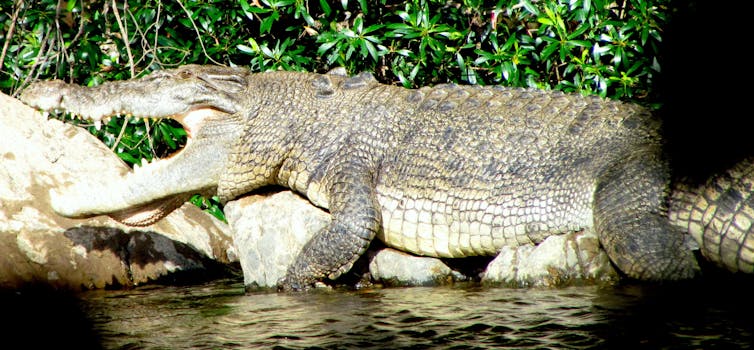 A saltwater crocodile named Brutus pictured on the Bloomfield River, north of Daintree in Queensland, in 2014.
Mike Darcy/AAP
Their maternal tenderness is equally important. They punctuate the landscape as powerful beings, reminding us to tread carefully, because the world is not arranged for our pleasure alone. This resonated with Val who understood “life as a circulation, as a gift from a community of ancestors”. Death, whether by crocodile or otherwise, is recycling, a “flowing into an ecological and ancestral community of origins”.
In the time it took me to write this, a man named Andrew Heard was taken from his dingy in that tangle of creeks in North Queensland where I still work. The police found his vessel upside down and some of his remains in the mangroves. They caught a four-metre crocodile, cut it open, and found the rest of him inside.
Then they killed another one. We could just keep going, get rid of them all. Fifty years ago, we almost did. At a time like this, with everyone reeling in shock, and grappling with some measure of personal fear, I understand the impulse.
I’m going out there again tomorrow, as usual. Older now, my fear and fascination have turned into something else. Despite their intentions for us, I like having them around. To me, they are indicators — but they indicate more than warm winters and big barramundi. They indicate a living world, giving and taking, and a society that’s starting to find its place in it.
As I motor down the creek, they punctuate the landscape, reminding me that we’ve decided, together, there are lives that matter beside our own. That despite the pain we may face in the future, we’re beginning to find our way. They indicate hope.
This essay received an Honourable Mention in the 2021 Nature Writing Prize.
A saltwater crocodile named Brutus pictured on the Bloomfield River, north of Daintree in Queensland, in 2014.
Mike Darcy/AAP
Their maternal tenderness is equally important. They punctuate the landscape as powerful beings, reminding us to tread carefully, because the world is not arranged for our pleasure alone. This resonated with Val who understood “life as a circulation, as a gift from a community of ancestors”. Death, whether by crocodile or otherwise, is recycling, a “flowing into an ecological and ancestral community of origins”.
In the time it took me to write this, a man named Andrew Heard was taken from his dingy in that tangle of creeks in North Queensland where I still work. The police found his vessel upside down and some of his remains in the mangroves. They caught a four-metre crocodile, cut it open, and found the rest of him inside.
Then they killed another one. We could just keep going, get rid of them all. Fifty years ago, we almost did. At a time like this, with everyone reeling in shock, and grappling with some measure of personal fear, I understand the impulse.
I’m going out there again tomorrow, as usual. Older now, my fear and fascination have turned into something else. Despite their intentions for us, I like having them around. To me, they are indicators — but they indicate more than warm winters and big barramundi. They indicate a living world, giving and taking, and a society that’s starting to find its place in it.
As I motor down the creek, they punctuate the landscape, reminding me that we’ve decided, together, there are lives that matter beside our own. That despite the pain we may face in the future, we’re beginning to find our way. They indicate hope.
This essay received an Honourable Mention in the 2021 Nature Writing Prize.
Authors: Michael Bradley, Postdoctoral Research Fellow, James Cook University



















